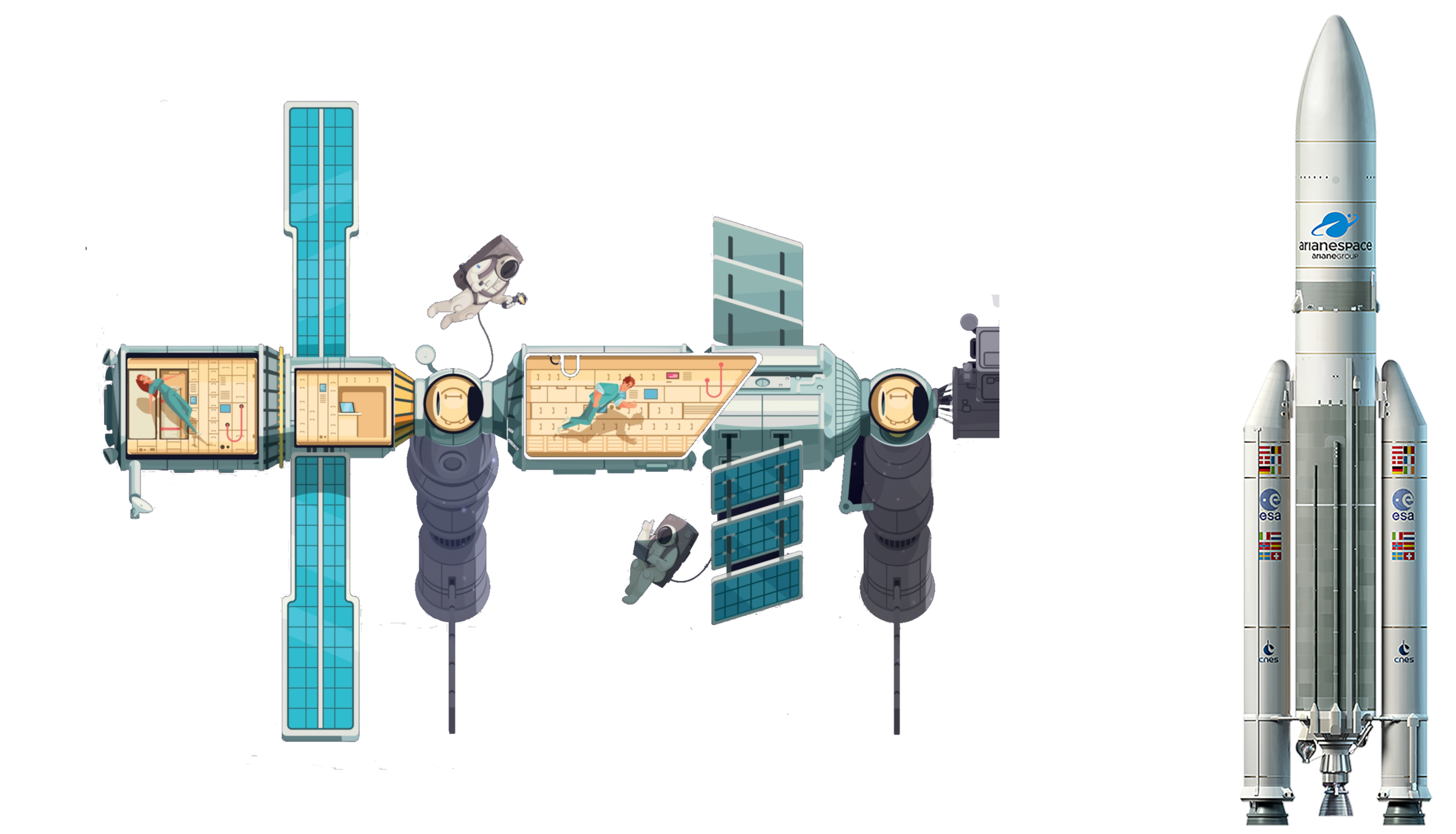
宇宙是所有时间、空间与其包含的内容物所构成的统一体[8][9][10][11];它包含了行星、恒星、星系、星系际空间、次原子粒子以及所有的物质与能量,宇指空间,宙指时间。目前人类可观测到的宇宙,其距离大约为93 × 109光年(28.5 × 109秒差距)[2],最大为27,160百万秒差距;而整个宇宙的大小可能为无限大,但未有定论[12]。物理理论的发展与对宇宙的观察,引领着人类进行宇宙构成与演化的推论。
根据历史记载,人类曾经提出宇宙学、天体演化学与科学模型,解释人们对于宇宙的观察。最早的理论为地心说,由古希腊哲学家与印度哲学家所提出[13][14]。数世纪以来,逐渐精确的天文观察,引领尼古拉斯·哥白尼提出以太阳系为主的日心说,以及经约翰内斯·开普勒改良的椭圆轨道模型;最终艾萨克·牛顿的重力定律解释了前述的理论。后来观察方法逐渐改良,引领人类意识到太阳系位于数十亿恒星所形成的星系,称为银河系;随后更发现,银河系只是众多星系之一。在最大尺度范围上,人们假定星系的分布平均,且各星系在各个方向之间的距离皆相同,这代表着宇宙既没有边缘,也没有所谓的中心。透过星系分布与谱线的观察,产生了许多现代物理宇宙学的理论。20世纪前期,人们发现到星系具有系统性的红移现象,表明宇宙正在膨胀;借由宇宙微波背景辐射的观察,表明宇宙具有起源[15]。最后,1990年代后期的观察,发现宇宙的膨胀速率正在加快[16],显示有可能存在一股未知的巨大能量促使宇宙加速膨胀,称做暗能量。而宇宙的大多数质量则以一种未知的形式存在着,称做暗物质。
大爆炸理论是当前描述宇宙发展的宇宙学模型。目前主流模型,推测宇宙年龄为137.99±0.21 亿年。大爆炸产生了空间与时间,充满了定量的物质与能量;当宇宙开始膨胀时,物质与能量的密度也开始降低。在初期膨胀过后,宇宙开始大幅冷却,引发第一波次原子粒子的组成,稍后则合成为简单的原子。这些原始元素所组成的巨大星云,借由重力结合起来形成恒星[1][17]。
目前有各种假说正竞相描述著宇宙的终极命运。物理学家与哲学家仍不确定在大爆炸前是否存在任何事物;许多人拒绝推测与怀疑大爆炸之前的状态是否可侦测。目前也存在各种多重宇宙的说法,其中部分科学家认为可能存在着与现今宇宙相似的众多宇宙,而现今的宇宙只是其中之一[18][19]。
Das Universum (von lateinisch universus ‚gesamt‘), auch der Kosmos oder das Weltall genannt, ist die Gesamtheit von Raum, Zeit und aller Materie und Energie darin. Das beobachtbare Universum beschränkt sich hingegen auf die vorgefundene Anordnung aller Materie und Energie, angefangen bei den elementaren Teilchen bis hin zu den großräumigen Strukturen wie Galaxien und Galaxienhaufen.
Die Kosmologie, ein Teilgebiet sowohl der Physik als auch der gegenwärtigen Philosophie der Naturwissenschaften, befasst sich mit dem Studium des Universums und versucht Eigenschaften des Universums wie beispielsweise die Frage nach der Feinabstimmung der Naturkonstanten zu beantworten.
Die heute allgemein anerkannte Theorie zur Beschreibung der großräumigen Struktur des Universums ist das Standardmodell der Kosmologie. Sie beruht auf der allgemeinen Relativitätstheorie in Kombination mit astronomischen Beobachtungen. Auch die Quantenphysik hat wichtige Beiträge zum Verständnis speziell des frühen Universums der Zeit kurz nach dem Urknall geliefert, in dem die Dichte und Temperatur sehr hoch waren. Wahrscheinlich wird ein erweitertes Verständnis des Universums erst erreicht, wenn die Physik eine Theorie entwirft, die die allgemeine Relativitätstheorie mit der Quantenphysik vereint. Diese „Theory Of Everything“ oder auch Weltformel genannte Theorie der Quantengravitation soll die vier Grundkräfte der Physik einheitlich erklären.
宇宙(うちゅう)とは、以下のように定義される。
- コスモス。時間・空間内に秩序をもって存在する「こと」や「もの」の総体[1]。何らかの観点から見て、秩序をもつ完結した世界体系。
- 全ての時間と空間、およびそこに含まれるエネルギーと物質[1]。あらゆる物質や放射を包容する空間[2]。あらゆる物事(森羅万象)を含む全ての存在。
- ビッグバン理論等で統一的に説明されうる、現実的、現在的に我々が暮らすひとつの広大な世界。ユニバース。もしくはその外側に仮想されるユニバースの複合体全体。(「ユニバース」という語には「ひとつ」という意味が込められているが、最近では、宇宙について論じる時、3次元的につながった空間だけではなく、平行宇宙も含めて論じられることがある。複合的宇宙もしくは多元的宇宙という意味で「マルチバース」と呼ばれる。単一宇宙と区別して複合宇宙全体を指す場合には特に「オムニバース」ともいう。)
- 3次元空間的に繋がった広大な宇宙全体を指すこともある。[要検証]
- 宇宙空間。地球の地上約100km以上、上空の空間を指す便宜的な定義[注釈 1]。
The Universe (Latin: universus) is all of space and time[a] and their contents,[10] including planets, stars, galaxies, and all other forms of matter and energy. While the spatial size of the entire Universe is unknown,[3] it is possible to measure the size of the observable universe, which is currently estimated to be 93 billion light-years in diameter. In various multiverse hypotheses, a universe is one of many causally disconnected[11] constituent parts of a larger multiverse, which itself comprises all of space and time and its contents;[12] as a consequence, ‘the Universe’ and ‘the multiverse’ are synonymous in such theories.
The earliest cosmological models of the Universe were developed by ancient Greek and Indian philosophers and were geocentric, placing Earth at the center.[13][14] Over the centuries, more precise astronomical observations led Nicolaus Copernicus to develop the heliocentric model with the Sun at the center of the Solar System. In developing the law of universal gravitation, Isaac Newton built upon Copernicus' work as well as Johannes Kepler's laws of planetary motion and observations by Tycho Brahe.
Further observational improvements led to the realization that the Sun is one of hundreds of billions of stars in the Milky Way, which is one of at least hundreds of billions of galaxies in the Universe. Many of the stars in our galaxy have planets. At the largest scale, galaxies are distributed uniformly and the same in all directions, meaning that the Universe has neither an edge nor a center. At smaller scales, galaxies are distributed in clusters and superclusters which form immense filaments and voids in space, creating a vast foam-like structure.[15] Discoveries in the early 20th century have suggested that the Universe had a beginning and that space has been expanding since then,[16] and is currently still expanding at an increasing rate.[17]
The Big Bang theory is the prevailing cosmological description of the development of the Universe. Under this theory, space and time emerged together 13.799±0.021 billion years ago[2] and the energy and matter initially present have become less dense as the Universe expanded. After an initial accelerated expansion called the inflationary epoch at around 10−32 seconds, and the separation of the four known fundamental forces, the Universe gradually cooled and continued to expand, allowing the first subatomic particles and simple atoms to form. Dark matter gradually gathered, forming a foam-like structure of filaments and voids under the influence of gravity. Giant clouds of hydrogen and helium were gradually drawn to the places where dark matter was most dense, forming the first galaxies, stars, and everything else seen today. It is possible to see objects that are now further away than 13.799 billion light-years because space itself has expanded, and it is still expanding today. This means that objects which are now up to 46.5 billion light-years away can still be seen in their distant past, because in the past, when their light was emitted, they were much closer to Earth.
From studying the movement of galaxies, it has been discovered that the universe contains much more matter than is accounted for by visible objects; stars, galaxies, nebulas and interstellar gas. This unseen matter is known as dark matter[18] (dark means that there is a wide range of strong indirect evidence that it exists, but we have not yet detected it directly). The ΛCDM model is the most widely accepted model of our universe. It suggests that about 69.2%±1.2% [2015] of the mass and energy in the universe is a cosmological constant (or, in extensions to ΛCDM, other forms of dark energy, such as a scalar field) which is responsible for the current expansion of space, and about 25.8%±1.1% [2015] is dark matter.[19] Ordinary ('baryonic') matter is therefore only 4.84%±0.1% [2015] of the physical universe.[19] Stars, planets, and visible gas clouds only form about 6% of ordinary matter, or about 0.29% of the entire universe.[20]
There are many competing hypotheses about the ultimate fate of the universe and about what, if anything, preceded the Big Bang, while other physicists and philosophers refuse to speculate, doubting that information about prior states will ever be accessible. Some physicists have suggested various multiverse hypotheses, in which our universe might be one among many universes that likewise exist.[3][21][22]
L'Univers est l'ensemble de tout ce qui existe, régi par un certain nombre de lois.
La cosmologie cherche à appréhender l'Univers d'un point de vue scientifique, comme l'ensemble de la matière distribuée dans l'espace-temps. Pour sa part, la cosmogonie vise à établir une théorie de la création de l'Univers sur des bases philosophiques ou religieuses. La différence entre ces deux définitions n'empêche pas nombre de physiciens d'avoir une conception finaliste de l'Univers (voir à ce sujet le principe anthropique).
Si l'on veut faire correspondre le mouvement des galaxies avec les lois physiques telles qu'on les conçoit actuellement, on peut considérer que l'on n'accède par l'expérience qu'à une faible partie de la matière de l'Univers1, le reste se composant de matière noire. Par ailleurs, pour expliquer l'accélération de l'expansion de l'Univers, il faut également introduire le concept d'énergie sombre. Plusieurs modèles alternatifs ont été proposés pour faire correspondre les équations et nos observations en prenant d'autres approches.
L'Universo è comunemente definito come il complesso che contiene tutto lo spazio e ciò che contiene,[1][2][3][4] cioè la materia e l'energia, i pianeti, le stelle, le galassie e il contenuto dello spazio intergalattico.[5][6]
L'osservazione scientifica dell'Universo, la cui parte osservabile ha un diametro di circa 92 miliardi di anni luce,[7] suggerisce che l'Universo sia stato governato dalle stesse leggi e costanti fisiche per la maggior parte della sua storia e in tutta la sua estensione osservabile, e permette inferenze sulle sue fasi iniziali. La teoria del Big Bang è il più accreditato modello cosmologico che descrive la nascita dell'Universo; si calcola che il Big Bang sia avvenuto circa 13,798 ± 0,037 miliardi di anni fa.[8]
La massima distanza teoricamente osservabile è contenuta nell'universo osservabile. Osservazioni di supernovae hanno dimostrato che l'Universo, almeno nella regione contenente l'universo osservabile, sembra espandersi a un ritmo crescente, e una serie di modelli sono sorti per prevederne il destino finale. I fisici sono incerti su che cosa abbia preceduto il Big Bang; molti si rifiutano di speculare, dubitando che si potranno mai trovare informazioni relative allo stato originario. Alcuni propongono modelli di universo ciclico, altri descrivono uno stato iniziale senza confini, da cui è emerso e si è espanso lo spaziotempo al momento del Big Bang.[9]
Alcune speculazioni teoriche sul multiverso di cosmologi e fisici ipotizzano che il nostro universo sia solo uno tra i molti che possono esistere.[10][11]
El universo es la totalidad del espacio y del tiempo, de todas las formas de la materia, la energía, el impulso, las leyes y constantes físicas que las gobiernan. Sin embargo, el término también se utiliza en sentidos contextuales ligeramente diferentes y alude a conceptos como cosmos, mundo o naturaleza.1 Su estudio, en las mayores escalas, es el objeto de la cosmología, disciplina basada en la astronomía y la física, en la cual se describen todos los aspectos de este universo con sus fenómenos.
La ciencia modeliza el universo como un sistema cerrado que contiene energía y materia adscritas al espacio-tiempo y que se rige fundamentalmente por principios causales. Basándose en observaciones del universo observable, los físicos intentan describir el continuo espacio-tiempo en el que nos encontramos, junto con toda la materia y energía existentes en él.
Los experimentos sugieren que el universo se ha regido por las mismas leyes físicas, constantes a lo largo de su extensión e historia. Es homogéneo e isotrópico. La fuerza dominante en distancias cósmicas es la gravedad, y la relatividad general es actualmente la teoría más exacta para describirla. Las otras tres fuerzas fundamentales, y las partículas en las que actúan, son descritas por el modelo estándar.
El universo tiene por lo menos tres dimensiones de espacio y una de tiempo, aunque experimentalmente no se pueden descartar dimensiones adicionales. El espacio-tiempo parece estar conectado de forma sencilla, y el espacio tiene una curvatura media muy pequeña o incluso nula, de manera que la geometría euclidiana es, como norma general, exacta en todo el universo.
La teoría actualmente más aceptada sobre la formación del universo, fue teorizada por el canónigo belga Lemaître, a partir de las ecuaciones de Albert Einstein. Lemaitre concluyó (en oposición a lo que pensaba Einstein), que el universo no era estacionario, que el universo tenía un origen. Es el modelo del Big Bang, que describe la expansión del espacio-tiempo a partir de una singularidad espaciotemporal. El universo experimentó un rápido periodo de inflación cósmica que arrasó todas las irregularidades iniciales. A partir de entonces el universo se expandió y se convirtió en estable, más frío y menos denso. Las variaciones menores en la distribución de la masa dieron como resultado la segregación fractal en porciones, que se encuentran en el universo actual como cúmulos de galaxias.
Las observaciones astronómicas indican que el universo tiene una edad de 13 799±21 millones de años (entre 13 778 y 13 820 millones de años con un intervalo de confianza del 68%) y por lo menos 93 000 millones de años luz de extensión.2
Debido a que, según la teoría de la relatividad especial, la materia no puede moverse a una velocidad superior a la velocidad de la luz, puede parecer paradójico que dos objetos del universo puedan haberse separado 93 000 millones de años luz en un tiempo de únicamente 13 000 millones de años; sin embargo, esta separación no entra en conflicto con la teoría de la relatividad general, ya que esta solo afecta al movimiento en el espacio, pero no al espacio mismo, que puede extenderse a un ritmo superior, no limitado por la velocidad de la luz. Por lo tanto, dos galaxias pueden separarse una de la otra más rápidamente que la velocidad de la luz si es el espacio entre ellas el que se dilata.
Observaciones recientes han demostrado que esta expansión se está acelerando, y que la mayor parte de la materia y la energía en el universo son las denominadas materia oscura y energía oscura, la materia ordinaria (bariónica), solo representaría algo más del 5 % del total.3
Las mediciones sobre la distribución espacial y el desplazamiento hacia el rojo (redshift) de galaxias distantes, la radiación cósmica de fondo de microondas, y los porcentajes relativos de los elementos químicos más ligeros, apoyan la teoría de la expansión del espacio, y más en general, la teoría del Big Bang, que propone que el universo en sí se creó en un momento específico en el pasado.
En cuanto a su destino final, las pruebas actuales parecen apoyar las teorías de la expansión permanente del universo (Big Freeze o Big Rip, Gran Desgarro), que nos indica que la expansión misma del espacio, provocará que llegará un punto en que los átomos mismos se separarán en partículas subatómicas. Otros futuros posibles que se barajaron, especulaban que la materia oscura podría ejercer la fuerza de gravedad suficiente para detener la expansión y hacer que toda la materia se comprima nuevamente; algo a lo que los científicos denominan el Big Crunch o la Gran Implosión, pero las últimas observaciones van en la dirección del gran desgarro.
Вселе́нная — не имеющее строгого определения понятие в астрономии и философии[комм. 1]. Оно делится на две принципиально отличающиеся сущности: умозрительную (философскую) и материальную, доступную наблюдениям в настоящее время или в обозримом будущем. Если автор различает эти сущности, то, следуя традиции, первую называют Вселенной, а вторую — астрономической Вселенной или Метагалактикой (в последнее время этот термин практически вышел из употребления).
В историческом плане для обозначения «всего пространства» использовались различные слова, включая эквиваленты и варианты из различных языков, такие как «космос», «мир»[1], «небесная сфера». Использовался также термин «макрокосмос»[2], хотя он предназначен для определения систем большого масштаба, включая их подсистемы и части. Аналогично, слово «микрокосмос» используется для обозначения систем малого масштаба.
Любое исследование, любое наблюдение, будь то наблюдение физика за тем, как раскалывается ядро атома, ребёнка за кошкой или астронома, ведущего наблюдения за отдалённой галактикой, — всё это наблюдение за Вселенной, вернее, за отдельными её частями. Эти части служат предметом изучения отдельных наук, а Вселенной в максимально больших масштабах, и даже Вселенной как единым целым занимаются астрономия и космология; при этом под Вселенной понимается или область мира, охваченная наблюдениями и космическими экспериментами, или объект космологических экстраполяций — физическая Вселенная как целое[3].
Предметом статьи являются знания о наблюдаемой Вселенной как о едином целом: наблюдения, их теоретическая интерпретация и история становления.
Среди однозначно интерпретируемых фактов относительно свойств Вселенной приведём здесь следующие:
| Самый распространённый элемент — водород. | Расширение Вселенной с хорошей точностью линейно до z ~ 0,1. | Реликтовый фон флуктуирует на масштабах четвёртого порядка малости. |
| Температура реликтового фона зависит от z. | Наличие Lα-леса в спектрах далёких объектов (квазаров) с z > 6. | Наличие сильной неоднородности в распределении галактик на масштабах < 100 Мпк. |
В основу теоретических объяснений и описаний этих явлений положен космологический принцип, суть которого в том, что наблюдатели, независимо от места и направления наблюдения, в среднем обнаруживают одну и ту же картину. Сами теории стремятся объяснить и описать происхождение химических элементов, ход развития и причину расширения, возникновение крупномасштабной структуры.
Первый значительный толчок в сторону современных представлений о Вселенной совершил Коперник. Второй по величине вклад внесли Кеплер и Ньютон. Но поистине революционные изменения в наших представлениях о Вселенной произошли лишь в XX веке.






 Aerospace
Aerospace
 Science and technology
Science and technology


